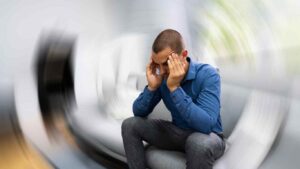Do you suffer from Vertigo (part 2)?
Words by Physio Helen Sibbald
 Have you experienced vertigo or dizziness or just a feeling of disequilibrium?
Have you experienced vertigo or dizziness or just a feeling of disequilibrium?
You may have a vestibular disorder, a problem with your neck or rarely, something more serious.
Physiotherapists can assess you to identify the cause and treat the disorder if appropriate; or guide you in the right direction for referral for further investigation.
The vestibular system is the part of your inner ear and brain that process information about balance and eye movements. Disease or injury to these processing parts can result in a vestibular disorder.
What is BPPV?
 BPPV(Benign Paroxysmal Positional Vertigo) is an extremely common vestibular disorder. 50% of people over the age of 65 with dizziness were diagnosed with BPPV and it is more common in adults and women.
BPPV(Benign Paroxysmal Positional Vertigo) is an extremely common vestibular disorder. 50% of people over the age of 65 with dizziness were diagnosed with BPPV and it is more common in adults and women.
The experience of BPPV can be devastating, frightening, and debilitating. Vertigo is a spinning, out of control feeling, very unpleasant. However, this is one of the easiest vestibular dysfunctions to identify and treat effectively.
There is usually an 80-90% success rate with only 1 treatment. Occasionally 2 treatments may be necessary to settle the vertigo.You would experience brief episodes of vertigo (spinning/turning) brought on by positional changes of the head with respect to gravity. Some examples: when you look up to a high shelf (BPPV is sometimes referred to as “top shelf vertigo”); when rolling over in bed; getting out of bed; lying down to one side or the other; washing hair, at dentist or the hairdressers; looking down…
In the acute phase of BPPV, this spinning may also be accompanied by nausea, vomiting, and sweating. Other symptoms BPPV sufferers complain of are: poor balance; trouble walking; lightheadedness; nausea; feeling queasy; spinning inside the head; a sense of tilt; sweating; a sense of floating; blurred vision; jumping vision.
BPPV is caused by the mechanical displacement of calcium carbonate crystals in the semicircular canals of the ear. We have calcium carbonate crystals in the utricle of our inner ear. The utricle may have been damaged by head injury or whiplash, infection, or other disorders of the inner ear, or may have degenerated because of advanced age. A crystal/crystals then becomes dislodged and moves into the fluid in the semicircular canals of our inner ear, causing vertigo.
To diagnose BPPV, your Dr or Physio trained in assessing and managing BPPV, would do some tests: one is a test called the Dix-Hallpike test.
During this test you would be gently moved from a sitting to a lying position, with your head in a certain position. This will bring on the vertigo and the tester will be watching your eyes for nystagmus (a non voluntary rhythmic oscillation of the eyes). If you cannot tolerate this position, a gentler, side-lying test can be performed.
Treatment is a simple repositioning manouevre to move the crystal through the canals back to the utricle , where they dissolve. The choice of treatment is determined by the ear canal affected and the type of BPPV. The practitioner will watch your reaction to the test and then perform the appropriate movements on you to reposition the crystal. (canalith repositioning manouevre).
Sometimes, having had BPPV, you have avoided the precipitating head/neck movements resulting in a stiff/painful neck or you may be left with some residual symptoms/balance issues. We may need to prescribe balance or vestibular ex’s or treat your neck with some manual therapy and therapeutic exercise.
Recurrences do occasionally occur, don’t be afraid, you now know what it is – come to your Physio for a reassessment and appropriate treatment.
Are there other causes of Dizziness?
There are numerous other causes of dizziness or vertigo and your Physio or Dr will ask many questions to determine the type, duration and precipitating factors. Because the neck, the postural system, the vestibular system and the eyes share some common pathways to the brain, we can do various tests involving your eyes and your head/neck movements, and balance and gait tests to diagnose or determine a pathway forward. You may require vestibular rehabilitation exercises, eye movement or eye stability exercises, balance exercises, BPPV canalith repositioning manouvres, or manual therapy and exercises for your neck. Or, we may recommend a referral to a specialist like an ENT or neurologist or an audiologist or optometrist.
There are some other commonly diagnosed vestibular disorders namely, labyrinthitis, vestibular neuritis, Meniere’s disease, Mal De Debarquement, vestibular migraine and others. Treatment may be medication and vestibular rehabilitation exercises.
If you experience moderate dizziness all the time (ie: not brought on by head position change), have a tendency to fall, have weakness in arms and/legs, pins and needles/numbness in your face/arm/leg, you may have a more serious problem requiring medical attention. Please see your Gp.
Helen Sibbald is available for consult. For appointments please phone 07 5500 6470 or Book Online

































